|
This gun had a long road to travel to gain acceptance onto USN ships. In 1977 the Chief of Naval Operations (CNO) approved their use to replace aging 20 mm Mark 16 guns, which were difficult to maintain and did not use standard NATO ammunition. However, the gun was not operationally evaluated for naval use until the summer of 1987. Then, with the urgent need for such weapons in the Persian Gulf, production of this weapon was greatly accelerated. Much of the necessary work was done at Naval Weapons Support Center Crane which was responsible for the design of the Mark 88 mounting. The Mark 38 Machine Gun System (MGS) denotes the Mark 242 when mounted on the Mark 88 Single Mounting. The Mark 38 MGS was employed aboard various combatant and auxiliary ships in the Mid-East Force escort operations and during Operations Desert Shield and Desert Storm. The weapons are maintained in a rotatable pool, available for temporary installation on various deploying ships and permanent installation on certain amphibious and auxiliary ships, patrol craft and Coast Guard cutters. In the event of a major malfunction, the gun can be removed from the mount and another one installed in its place in five minutes by two people. As the Mark 88 is manually trained and lacks stabilization, target tracking is difficult when the MGS is used on a small combatant ship. For this reason, the Navy started a program to develop a low-cost, remotely controlled and stabilized version designated as the Mark 38 Mod 2. Improvements compared to the Mark 38 include an on-mount electro-optical sight, improved ammunition loading, improved man/machine interface, an embedded trainer and ship roll compensation. The new system also provides the capability to have two different ammunition types loaded and selecting between them from the remote console. The remote operator console is a 12-inch (30.5 cm) color LCD equipped with 12 soft keys. The picture on the computer screen is extremely clear, displaying a real-time, 360-degree, 7,000 - 8,000 yard (6,400 - 7,300 m) picture. In 2003, successful testing was conducted aboard the USS Decatur (DDG-73) and USS Howard (DDG-83). USS Princeton (CG-59) was the first ship to have this weapon system permanently installed. Tests on Princeton demonstrated a very robust capability during day and night tracking and firing on a high speed maneuvering surface target (HSMST). During the live fire against the HSMST, the system gained a kill of the target at more than twice the range of the current Mod 1 gun. Other tests have shown a two to three fold increase in Probability of Hit (POH) versus the Mod 1. In 2004, United Defense received a $395.5 million contract to produce the Mark 38 Mod 2 weapon system. The contract runs through 2010 with the first eight units and spares to be delivered in 2004, 13 in 2005 and 67 in 2006. The Mark 96 Mod 0 is a two-axis stabilized mounting that contains both a 25 mm M242 chain gun and a 40 mm Mark 19 grenade machine gun. The system combines elements from the Mark 3 Mod 9 and Mark 38 gun mounts to provide a lightweight, low-cost solution to small-caliber gun requirements including a "man-in-the-loop" system for low-intensity combat situations. The operator sits on the mount, which moves to compensate for the pitch and roll of the ship. Rheinmetall AG has also adapted the M242 for a naval mounting designated as MLG 25. The USN purchased a total of 243 guns between FY1986 and FY1992. |

25 mm Mark 38 MGS on USS Ingraham FFG-61
in June 2003
|
| .
|